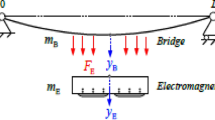Abstract
The stability and bifurcation behavior of the electromagnet-track beam coupling system of the electromagnetic suspension maglev vehicle are studied by the theoretical and numerical analyses. The stability domain of three key dynamics parameters of the track beam as well as the Lyapunov coefficient at the degenerated equilibrium point is calculated. The topological structure of the solution to the coupling system near the Bautin bifurcation point is determined. The results show that in the engineering practice, the intermediate frequency should be avoided in the natural frequency of the track beam; when a low frequency is taken, it should be reduced as much as possible; when a high frequency is taken, it should be increased as much as possible and the damping ratio should also be increased, so that the system can remain stable while a lighter-weight track beam is used, thereby reducing the engineering costs. Besides, when the parameters are near the Bautin bifurcation point, the system will have complex dynamics behaviors. Within a certain parameter range, multiple stable and unstable limit cycles exist simultaneously, so that the system tends to have different stable solutions under different initial disturbances.








Similar content being viewed by others
References
Alberts, T.E., Oleszczuk, G., Hanasoge, A.M.: Stable levitation control of magnetically suspended vehicles with structural flexibility. In: American Control Conference (2008)
Carr, J.: Applications of Centre Manifold Theory. Springer, New York (1981)
Han, H.S., Yim, B.H., Lee, N.J., et al.: Effects of the guideway’s vibrational characteristics on the dynamics of a maglev vehicle. Veh. Syst. Dyn. 47(3), 309–324 (2009)
Kim, K.J., Han, J.B., Han, H.S., Yang, S.J.: Coupled vibration analysis of maglev vehicle-guideway while standing still or moving at low speeds. Veh. Syst. Dyn. 53(4), 587–601 (2015)
Kuznetsov, Y.A.: Elements of Applied Bifurcation Theory. Springer, New York (1995)
Lee, H.W., Kim, K.C., Ju, L.: Review of maglev train technologies. IEEE Trans. Magn. 42(7), 1917–1925 (2006)
Li, J.: The Vibration Control Technology of EMS Maglev Vehicle-Bridge Coupled System. Doctor, National University of Defense Technology (2015)
Li, J.H., Li, J., Zhou, D.F., et al.: Self-excited vibration problems of maglev vehicle-bridge interaction system. J. Cent. South Univ. 21(11), 4184–4192 (2014)
Liang, X.: Study on MAGLEV Vehicle/Guideway Coupled Vibration and Experiment on Test Rig for A Levitation Stock. Doctor, Southwest Jiaotong University (2014)
Sedighi, H., Shirazi, K.: Bifurcation analysis in hunting dynamical behavior in a railway bogie: using novel exact equivalent functions for discontinuous nonlinearities. Sci. Iran. 19, 1493–1501 (2012)
Wang, H., Li, J.: Sub-harmonic resonances of the non-autonomous system with delayed position feedback control. Acta Phys. Sin. 56(5), 2504–2516 (2007)
Wang, H., Li, J., Zhang, K.: Stability and Hopf bifurcation of the maglev system with delayed speed feedback control. Acta Autom. Sin. 33(8), 829–834 (2007)
Wang, K., Luo, S., Ma, W., et al.: Dynamic characteristics analysis for a new-type maglev vehicle. Adv. Mech. Eng. 9(12), 1–10 (2017)
Yan, L.: Suggestion for selection of Maglev option for Beijing-Shanghai high-speed line. IEEE Trans. Appl. Supercond. 14(2), 936–939 (2004)
Zhang, J., Yang, Y., Zeng, J.: An algorithm criterion for Hopf bifurcation and its application in vehicle dynamics. Acta. Mech. Sin. 32(5), 596–605 (2000)
Zhang, T., Dai, H.: Bifurcation analysis of high-speed railway wheel-set. Nonlinear Dyn. 83(3), 1511–1528 (2016)
Zhang, L.: Research on Hopf Bifurcation and Sliding Mode Control for Suspension System of Maglev Train. Doctor, Hunan University (2010)
Zhang, M., Luo, S., Gao, C., et al.: Research on the mechanism of a newly developed levitation frame with mid-set air spring. Veh. Syst. Dyn. 56(12), 1797–1816 (2018)
Zhao, C., Zhai, W.: Dynamic characteristics of electromagnetic levitation systems. J. Southwest Jiaotong Univ. 39(4), 464–468 (2004)
Zhao, C., Zhai, W.: Guidance mode and dynamic lateral characteristics of low-speed maglev vehicle. China Railway Sci. 26(6), 28–32 (2005)
Zhou, D., Hansen, C.H., Li, J., et al.: Review of coupled vibration problems in EMS maglev vehicles. Int. J. Acoust. Vib. 15(1), 10–23 (2010)
Zobory, I., Nhung, T.: A mathematical investigation of the dynamics of drive-systems of railway traction vehicles under stochastic track excitation. Period. Polytech. Transp. Eng. 20, 101–107 (1992)
Zou, D., She, L., Zhang, Z., et al.: Maglev vehicle and guideway coupling vibration analysis. Acta Electron. Sin. 38(9), 2071–2075 (2010)
Acknowledgements
This study was funded by the National Natural Science Foundation of China (Grant Number 51875483), the National Key R&D Program of China (Grant Number 2016YFB1200601-A03) and Independent Topics of National Key Laboratories (Grant Number 2020TPL-T04).
Funding
This study was funded by the National Natural Science Foundation of China (Grant Number 51875483).
Author information
Authors and Affiliations
Corresponding author
Ethics declarations
Conflict of interest
The authors declare that they have no conflict of interest.
Additional information
Publisher's Note
Springer Nature remains neutral with regard to jurisdictional claims in published maps and institutional affiliations.
Appendix: Parameters of electromagnet-track beam coupling system in Sect. 4
Appendix: Parameters of electromagnet-track beam coupling system in Sect. 4
Parameter | Description | Value |
|---|---|---|
m | Mass of electromagnet | 550 kg |
g | Gravity acceleration | 9.8 m/s2 |
\( \mu_{0} \) | Permeability in vacuum | \( 4\pi \times 10^{ - 7} \;{\text{T}}\;{\text{m/A}} \) |
N | Coil turns of electromagnet core | 800 |
A | Area of the magnetic pole of the electromagnet | 0.014 m2 |
\( \delta_{0} \) | Rated levitation gap | 8 mm |
i 0 | Stable levitation current | 11.07 A |
k P | Gap feedback coefficient | 3500 |
k D | Velocity feedback coefficient | 300 |
k e | Current feedback coefficient | 25 |
Rights and permissions
About this article
Cite this article
Chen, X., Ma, W. & Luo, S. Study on stability and bifurcation of electromagnet-track beam coupling system for EMS maglev vehicle. Nonlinear Dyn 101, 2181–2193 (2020). https://doi.org/10.1007/s11071-020-05917-8
Received:
Accepted:
Published:
Issue Date:
DOI: https://doi.org/10.1007/s11071-020-05917-8




